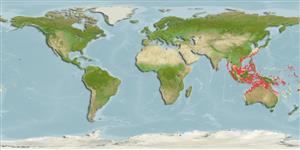>
Gobiiformes (Gobies) >
Gobiidae (Gobies) > Gobiinae
Etymology: Priolepis: Greek, prio = to saw + Greek,lepis = scale (Ref. 45335).
More on author: Weber.
Environment: milieu / climate zone / depth range / distribution range
Ecología
marino demersal; rango de profundidad 45 - 114 m (Ref. 85603). Tropical
Distribución
Países | Áreas FAO | Ecosistemas | Ocurrencias, apariciones | Point map | Introducciones | Faunafri
Indo-West Pacific: Thailand (Gulf of Thailand) Australia (WA to NT, Arafura Sea), Indonesia (New Guinea), and the Philippines (Samar Sea); probably widespread. First record from Myanmar, Andaman Sea (Ref. 126003).
Tamaño / Peso / Age
Maturity: Lm ? range ? - ? cm
Max length : 3.4 cm SL macho / no sexado; (Ref. 85603)
Short description
Claves de identificación | Morfología | Morfometría
Espinas dorsales (total) : 7; Radios blandos dorsales (total) : 10; Espinas anales: 1; Radios blandos anales: 8. This species is distinguished by the following characters: interorbital broad, with a slight depression between eyes; predorsal scales covered with ctenoid scales to above mideye, and a small naked patch immediately before first dorsal fin; scales absent immediately behind eye before transverse postocular papilla row; prepelvic area partly scaled immediately before pelvic origin, in 2-8 rows; usually no opercular scales, but rarely 1-5 small scales dorsally; no scales on; usually D2 I,10, A I,8, pectoral rays 19; transverse pattern of sensory papilla rows on cheek; pelvic fins connected to form a plate, but no interspinal membrane, the fifth ray with multiple branches, length about 75-80% of length of fourth ray; head and body brown with a distinct large black blotch at anterior base of first dorsal fin, and in life, head and body with very thin blue bands; no bands dorsally on caudal fin; mouth very oblique, jaws form an angle for 55°-60° with body axis (Ref. 85603).
Inhabits reef crevices (Ref. 90102).
Life cycle and mating behavior
Madurez | Reproducción | Puesta | Huevos | Fecundidad | Larva
Hoese, D.F. and H.K. Larson, 2010. Description of two new species of the genus Priolepis from the Indo-Pacific with redescription of Priolepis profunda and Priolepis psygmophilia. Ichthyol. Res. 57(3):367-372. (Ref. 85603)
IUCN Red List Status (Ref. 130435: Version 2024-2)
Threat to humans
Harmless
Human uses
Herramientas
Special reports
Download XML
Fuentes de Internet
Estimates based on models
Preferred temperature (Ref.
123201): 23.2 - 28.2, mean 27.1 °C (based on 298 cells).
Phylogenetic diversity index (Ref.
82804): PD
50 = 0.5000 [Uniqueness, from 0.5 = low to 2.0 = high].
Bayesian length-weight: a=0.01023 (0.00477 - 0.02194), b=3.01 (2.83 - 3.19), in cm total length, based on LWR estimates for this (Sub)family-body shape (Ref.
93245).
Nivel trófico (Ref.
69278): 3.1 ±0.3 se; based on size and trophs of closest relatives
Resiliencia (Ref.
120179): Alto, población duplicada en un tiempo mínimo inferior a 15 meses (Preliminary K or Fecundity.).
Fishing Vulnerability (Ref.
59153): Low vulnerability (10 of 100).
